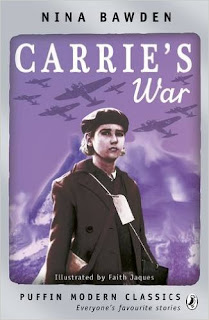I would certainly call reading this book an experience, and to be honest i'm not sure if it's a good one or a bad one. I've literally just put this book down, and my over-riding emotions right now are that of bafflement, confusion and possibly a little sadness! What a bizarre book! Within the first few pages it had me thinking of the twentieth century Modernist texts that I had studied during my degree, with their symbolism and philosophical approach to, and examination of, modern life. It seemed a very grown-up book, yet it seem to deride grown-ups and their outlook on the world, in a way that Peter Pan or Roald Dahl might be proud of! I was thoroughly confused. In front of me was a book that I had initially associated with adult literature, yet it spoke to me in the voice of children's fiction....
This is the way the book begins,
But look again, it is in fact not a hat, but a boa constrictor eating an elephant, from the outside. This surreal image really appealed to me, and I began warming to my narrator! Especially when I was then presented with this,
A boa constrictor eating an elephant, from the inside! As amusing as this was, it was all making an important point; grown-ups forget how to use their imagination, and have to have all the obvious things explained to them! Very Roald Dahl don't you think!
The story, in which a pilot stranded in the Sahara Desert meets a Little Prince from outer space, is punctuated with philosophical and moral moments such as these. On the official Little Prince website I am told that it is a story of a grown-up meeting his inner child, and this makes a lot of sense, but also no sense at all, a recurring theme in most of the book! I tried so hard to understand the deeper elements of this book, yet struggled to understand quite what the point was. It seemed to be stuffed full of comments on humanity, responsibility, vice, greed, selfishness, ignorance, the perils of growing up, the plight of the grown-up, love, grief, friendship, childhood, and happiness. These can be seen as The Little Prince journeys across space visiting various planets, each home to another personified vice of man.
If we are to believe the idea of an adult meeting with the inner child then the ending seems to make sense. The Little Prince must leave, and like in all good children's books that deal with magic, be it Mary Poppins or Peter Pan, this way of looking at the world must be given up, isolated within childhood and never cross over into adulthood, a time of responsibility and sense. However, the narrator does ask us to keep a look out for the return of The Little Prince, just in case he can relive a glimmer of this childlike outlook on life. There is an element of sadness here, as if he, as an adult, longs for a life that is much simpler and happier. However, you could also say that the Prince was in fact a hallucination of a desperate man, stranded in the desert, slowly loosing consciousness. It's hard to tell. So many questions and things to make you think, and all squished into just around 90 pages!
I had heard of this book prior to reading it, and had been told it was a classic of children's literature loved by children and adults alike. But this was all I knew. I had no idea what is was about, or what made it so special. I'm afraid to say, i'm still a little in the dark. However, here are a few things that I do know about The Little Prince,
- 150 million copies of the book have been sold worldwide.
- There have been 300 translations.
- 400 million people and counting have read it!
- There's a film, i've seen the trailer and it looks quite good!
- There was a The Little Prince TV series, which was shown in 50 countries.
- There's a The Little Prince musical.
- There was a 4D ride shown in theme parks across the world!
- There is a Le Petit Prince shop in Paris full to the brim with official merchandise!
- There is a charity foundation.
- In France you can go to The Little Prince theme park.
- In Japan you can visit The Little Prince Museum.
- In Korea you can go to The Little Prince Village.
- This year an astronaut took a figurine of The Little Prince to the International Space Station!!
So clearly, there is something rather special about this book, and it's name sake! It is quaint, and the image of The Little Prince alone on his asteroid, barely bigger than him, with his 3 volcanos, his rose and his baobab shoots, is one not easily forgotten, yet I do wonder what the rest of it is for.... Maybe there's a secret meaning that i'm yet to discover. I will probably read this book again just to make sure i'm not missing anything.
The Little Prince was one of Antoine de Saint-Exupery's last books. In 1944, just 2 years after it's publication, he died when his plane was shot down whilst on a mission for the Free French Forces. I likened Saint-Exupery to Roald Dahl at the start of this post, and it strikes me as a fitting comparison. Here are two men, both airforce pilots during the second world war, seeing things that were no doubt truly horrific, and being asked to defend their countries and risk their lives no matter what was thrown at them. It's not surprising really that they lost their faith in the adult world is it?
Thanks for reading, L x
Next up a look at Charmed Life by Diana Wynne Jones, the first book in her Chrestomanci series.

























